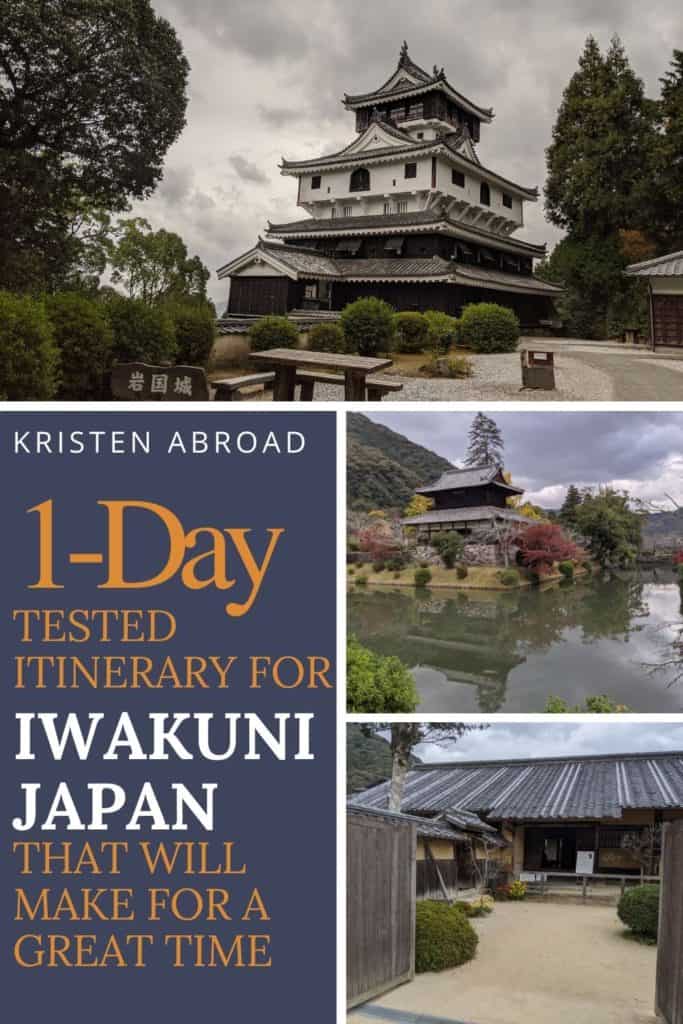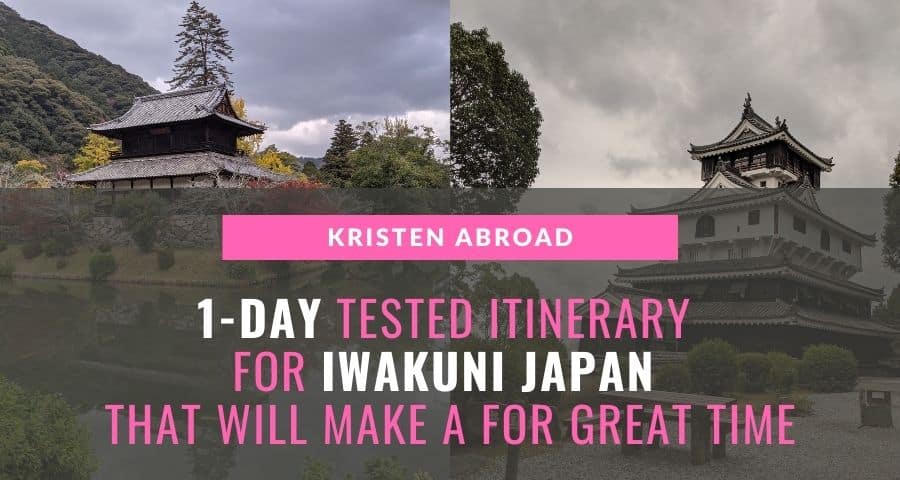15 minutes on the Shinkansen or 50 minutes on the JR Sanyo line from Hiroshima and you will find yourself in the city of Iwakuni in Yamaguchi Prefecture. Great for a day trip after you’ve explored Miyajima and Hiroshima, especially if you have a thing for Japanese castles.
- Getting to Iwakuni
- Honke Matsugane Visitor Center
- Kintaikyo (錦帯橋)
- How to get to Iwakuni Castle: Ropeway or Hike?
- Iwakuni Castle (岩国城)
- Mechanical Clock (からくり時計) and Walking loop
- Kikko Park (吉香公園)
- Cormorant (ウミウ) and Festivals
- Kagawa Family Nagayamon (香川家長屋門)
- Kikkawa Family Archives (吉川家文書)
- Former Mekada Residence (旧目加田家住宅)
- Kikko Shrine (吉根神社)
- Local foods of Iwakuni Japan
- Where to find Iwakuni Souvenirs or Omiyage
- Heading on? See JR Nishi-Iwakuni Station
- Other things in Iwakuni to extend your trip
- Things to do in Yamaguchi Prefecture
Disclosure: Kristenabroad.com is a participant in the Amazon Services LLC Associates Program and other affiliate programs. For some links to products or services in this article, I may earn a small commission by you using my link. The price for you is not affected.
Getting to Iwakuni
If you are making max dollar value use of a JR Rail Pass (and/or just going for the time savings), you’ll want to take the JR Sanyo Shinkansen Line to Shin-Iwakuni Station (新岩国駅). Make sure if you are looking at Hyperdia (my train schedule app of choice, for that and lots of other info about trains, check here) you put “SHIN”-Iwakuni, otherwise you’ll 1) not be on the shinkansen and 2) not be close to the sights! This is the best option if you are coming from further out than Hiroshima.
To get to the sights, you’ll want to get on a local bus heading towards Kintaikyo Bus Terminal. The buses are right outside the shinkansen station. Or if you want a bit of hike/walk, it’s about 5 km. If you are making this a day trip, even though I walk super fast, I suggest the bus. There is a ton to see!
Your other option from Hiroshima is to take the (nearly 5 times!) slower local JR Sanyo line to JR Iwakuni Station (no precursor this time) which hugs the water a bit more. At JR Iwakuni, switch trains to the JR Gantoku Line and get off at JR Nishi-Iwakuni. It’s slower but costs 1/4 the price, so it will depend if you have the JR rail pass at your disposal or care about the difference – time is money after all. From there you can walk just over a mile or take the bus to Kintaikyo Bus Terminal, in this case, they are about the same time-wise.
Honke Matsugane Visitor Center
If you’ve been following along, you know that one of my first stops while traveling in Japan is the local visitor center. You can see what events are happening and get an idea of anything you might have missed when researching ahead of time.
However, this visitor center isn’t just for pamphlets. Honke Matsugane was originally a shop from the mid-1800s for hair oils used to harden the top knot of samurai. They refurbished it so you can get a feel for the times, there are some other older buildings close by to admire as well!
Inside you’ll also find some information about the local history and there are cultural events as well as the ability to try some local food and sake (for a fee). It’s on the same side of the river as the bus terminal so you’ll want to start here.
Public restrooms are honestly really easy to find in Japan and aren’t charged normally (unless you are climbing Mount Fuji) but if you need one, there is one here!
Kintaikyo (錦帯橋)
You will have seen Kintaikyo (錦帯橋) on your way to the visitor center. Time to see it up close and personal!
Kintaikyo (錦帯橋) or Kintai Bridge as it would be in English (bridge in Japanese 橋, can be pronounced “bashi” or “kyo”) is one of the most famous bridges in Japan, if not the world. As we like to have lists of top 3 (and top 100 for that matter) in Japan, Kintaikyo makes the list of 日本三名橋 (Nihon Sanmeikyo, Three Famous Bridges of Japan).
Your daily trivia from Kristen Abroad: What are the top 3 bridges of Japan? Kintaikyo (錦帯橋); Meganebashi (眼鏡橋) in Nagasaki; and the Nihonbashi (日本橋) in Tokyo. While those last two are sometimes contested, Kintaikyo is always on the “list”. Perhaps that contention is why there are also top 3 lists for the three oldest bridges and 3 strangest (which Kintaikyo is also on)! There are also three top sacred bridges…I’m going to stop researching…
What we now know as Kintaikyo (it’s had several names over the years) is the result of trial and error. The third lord (more on him in a bit) was tired of the bridge being washed away due to its wooden posts, and let’s face it, a lot of water coming through from the mountains. When Kintaikyo was built in 1673 with stone, it was cutting-edge technology and prized as “the bridge that would never be washed away”.
Which is ironic, as it did during a flood the following year. But with some tweaks to the construction, they got it right and there it stood for nearly 300 years when a monster typhoon hit in 1950. (It didn’t help it was in slight disrepair after being neglected during WWII).
The five arched bridge you see today was rebuilt by the people of Iwakuni in 1953 and further restored in 2004. The original use was to connect the two sides of the castle town that spanned the Nishiki river in the middle. But it wasn’t necessarily a complete convenience as the people of the area had to pay 橋でまえ (hashidemae, before the bridge) tax to keep up the bridge. It’s made of wood after all, very easy to rot. Which to be fair, you are kind of paying something similar with your admission fee!
As if the top 3 designation wasn’t enough for this beauty, in 2020, it was designated as an illuminated Night View Heritage (ライトアップ夜景遺産). There are four different “types” of night view heritages with a total of 226 in the country, more on that another time. It was also in 2020 designated as one of the top 100 moon views in the country (we love our lists of 100 here in Japan!). They are actually still working on completing the entire list but Iwakuni between Kintaikyo and the castle is number 54.
I recommend getting the combo pass for the bridge, ropeway, and castle entrance fees which you can get at the entrance to the Kintai Bridge for 970 yen (about $9 USD). This will save you a bit of money.
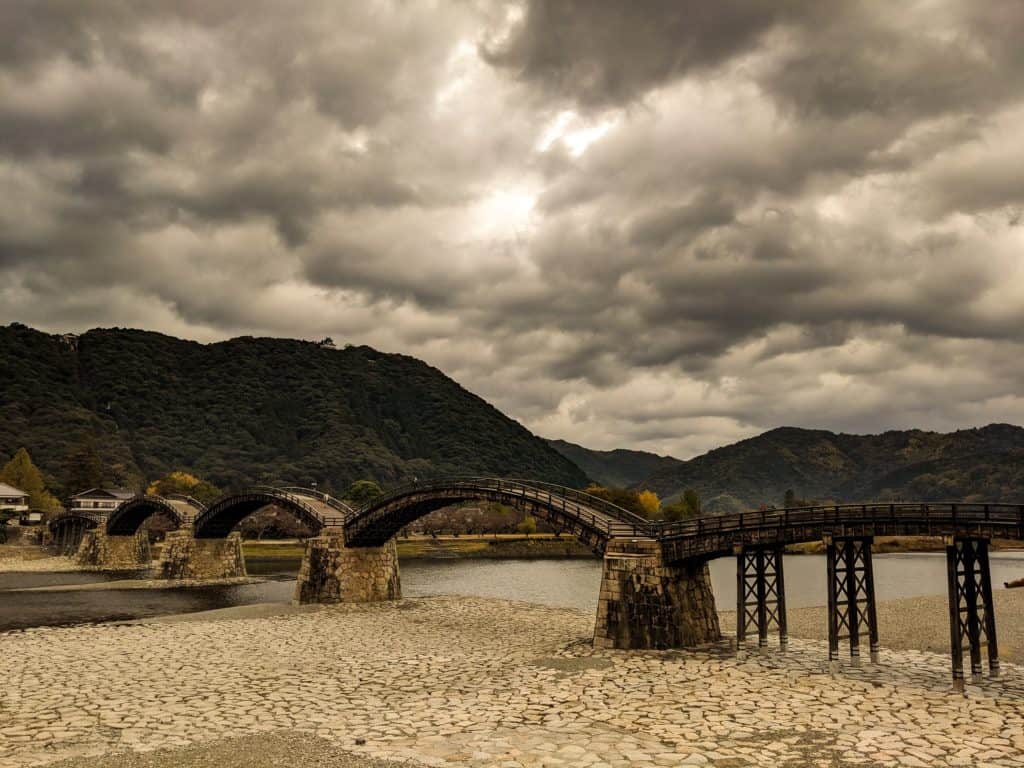
How to get to Iwakuni Castle: Ropeway or Hike?
Since the package deal on admissions you may have bought at the bridge include the ropeway and castle, we’ll discuss this first, as to get there you have to walk through or near many of the other things to see in Iwakuni.
The amount of activities I’m presenting to you doesn’t necessarily bode well for a hike added in time-wise if you are trying to do just a day trip, but if you’d like the extra exercise, it’s completely doable. Per All Trails, there are actually two ways up. The super steep option near the ropeway or a more leisurely slope. Either way, you’ll be connecting with the trail at the top to walk to the castle.
If it’s not too cold, I love hiking in my Teva Verra Sandal. They are low profile and lightweight. And yes, I’m a weirdo that hikes in sandals! They work great for urban hiking as well. Otherwise, I stick to my Merrell Vapor Gloves. As a side note, it’s always a good idea to have an umbrella on you in Japan, just in case. Especially if it is during the rainy season. For a daypack to carry things in, I’m an Osprey girl through and through, they have plenty of sizes to go with but I usually find the 13L option to be sufficient. Especially when I’m using a “hub” location, like Okayama to keep my stuff at.
If you don’t want to hike the 200 meters up Yokoyama mountain, you can try the ropeway! And as mentioned, the package will save you on the up and back trip. The ropeway runs every 20 minutes and takes just 3 minutes to get to the top. On clear days you can see out to the islands on the Seto Inland Sea which is beautiful (I even saw them on a cloudy/rainy day), including Miyajima.
If you decide to hike, paying for the bridge and castle separately ends up being around the same price as the package of the three.
Iwakuni Castle (岩国城)
Once you’re at the top by the ropeway, it’s a fairly short walk over to Iwakuni Castle. You’ll be heading right if you were looking at the mountain from the bottom and there are two paths to get there. I suggest doing it as a loop so you can see more, like the well on the backside of the mountain from town.
One of the 100 finest castles of Japan, Iwakuni Castle was built from 1603-1608 (what did I say about them all being built around the same time?). However, it didn’t make it to 10 years old on top of its perch on Yokoyama.
Not all castles are lost in wars or burned from fires, by the way. When the Tokugawa Feudal Government was put into place in Japan they passed a “One Castle per One Province Order”. It was strictly enforced so a good chunk of the castles were removed by this going into place. The ruins remained after all this time though and in the 1950s, along with all the other castle rebuilding, Iwakuni was done up.
Funnily though, they decided to move the castle about 50 meters from its original location so that you could see it from Kintaikyo below. Makes a better postcard, I suppose. They did some reconstruction work on the original foundation so you can get a feel for it when you visit.
Some of the original walls leading to the castle were never taken down though so you can still see those. I learned from one of the signs that it seems it was the lord “sticking it” to the policy under the guise of “it will fall down otherwise” and was left for the support of the embankments which makes me laugh.
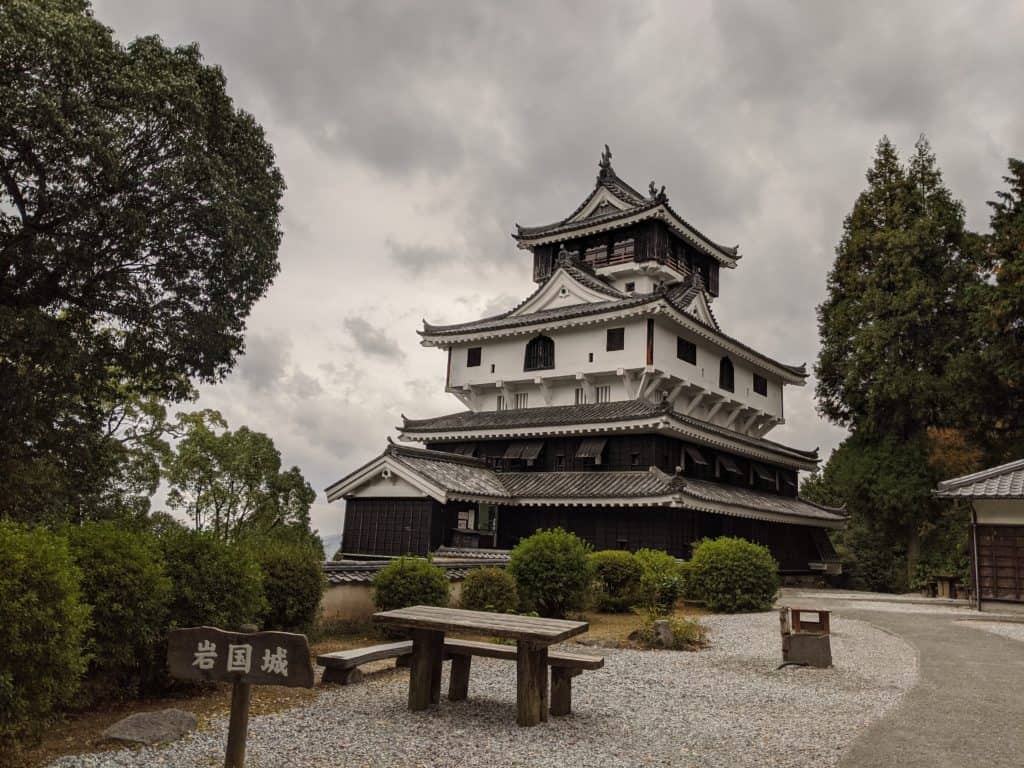
Mechanical Clock (からくり時計) and Walking loop
On top of the mountain while you are waiting for your ropeway trip back down, try and catch one of the mechanical clock performances that happen every 15 minutes or so. The dolls inside will move and it plays music that is important to Iwakuni.
While I didn’t end up going, there is a walking loop towards the other side of the mountain as well with some other views. I considered those from the castle and the ropeway landing sufficient but who knows, I might have missed out! Next time, as I always say ;).
Kikko Park (吉香公園)
I could have just as easily listed these next couple of things before the castle, as you have to walk through Kikko Park to get to the ropeway. Whichever floats your boat! I’d choose based on the current weather to ensure some good views.
The Kikko Park is at the base of the “mountain” that holds Iwakuni Castle (200 meters isn’t very high). It is the former residence of the feudal lord and after you’ve passed over the Kintai Bridge, you’ll see a statue of a stately man – because Japan loves statues. This gentleman is Kikkawa Hiroyoshi, the third lord and also the one that started the bridge construction of stone.
Kikko Park was named one of the 100 top historical parks in the country (what did I say about lists of 100?). There’s actually a lot more than 100 now but who’s counting? They were on the original list.
Cormorant (ウミウ) and Festivals
A traditional way of fishing in the Nishiki river which flows under the Kintai Bridge is to use cormorant. A very large bird that you can see at the Cormorant Facility near the base of Yokoyama in Kikko Park.
Fishermen on barges burn fires on these long poles to attract the fish and use the birds to help catch them. It’s like they are walking a dog, but it’s a bird in the water with a leash around its neck. It dives down and grabs a fish, if they get one, the fisherman pulls the bird into the boat and gets the fish out of its mouth.
As someone who used to fish, it’s quite fascinating. In the summertime evenings, you can see this method, called 鵜飼い (ukai) in action. I’ve only seen the videos, I want to see the festival! They have boats you can get a spot on to see it up close!
You can also take rides at other times of the year (and surprisingly for me who loves boat rides, I left that one for the next time I’m in Iwakuni!).
Just for good measure, Iwakuni is also one of the 100 best cherry blossom viewing spots in Japan if you happen to be there in Spring time. The trees line the river and many are in Kikko Park.
Kagawa Family Nagayamon (香川家長屋門)
Designated a cultural asset of the prefecture (not national like others), this gate and the two surrounding tenement houses are thought to date back to 1690. The Kagawa family was the minister of Iwakuni’s Lord Kikkawa. The architecture is a typical example of what you would see in a samurai house and with views of Kikko park, it is quite lovely.
The residence is still used (!) so you can’t see inside but you can see the gate at least.
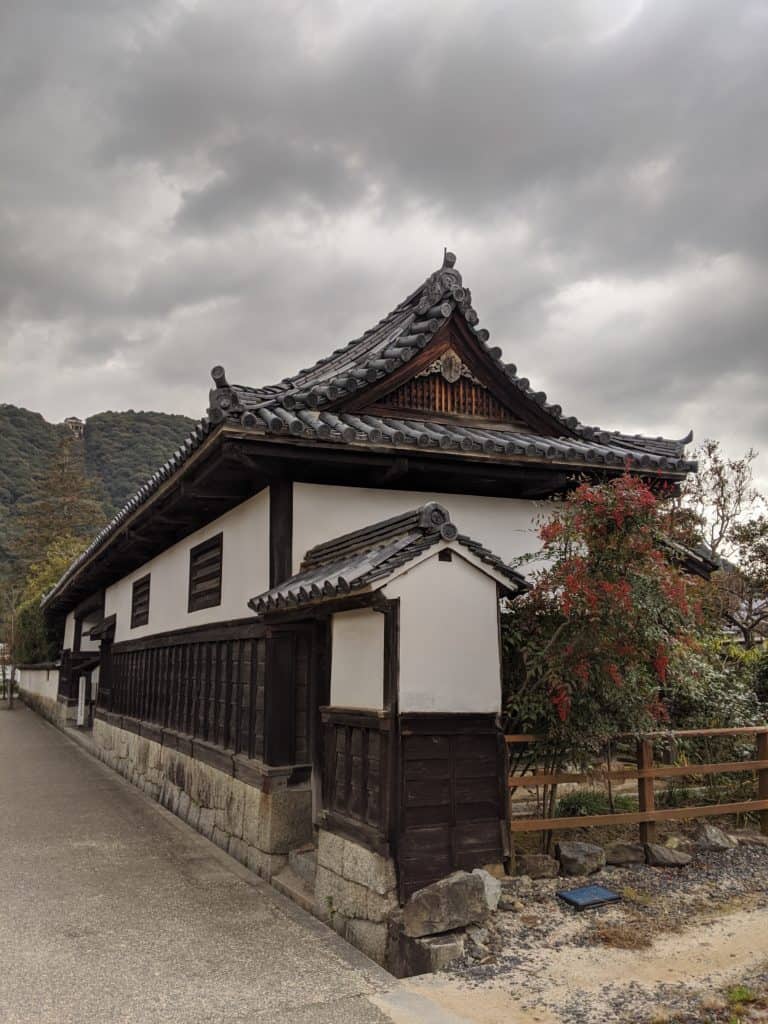
Kikkawa Family Archives (吉川家文書)
In a stately looking building (similar to the gate above), you can see a museum which has a collection of about 7,000 historical materials, arts and crafts, which have been handed down through the Kikkawa family, which has a history of 800 years.
The Kikkawa family was a samurai clan, probably most famously that one of them was a general of Toyotomi Hideyoshi, the Japanese shogun that was the “great unifier” of Japan.
The documents themselves are designated as important cultural assets. If you don’t have time though, the building by itself is quite beautiful.
Former Mekada Residence (旧目加田家住宅)
When the Kikkawa’s came to Iwakuni, so did the Mekada’s. For some more history of the area, check out this middle-class samurai residence, designated as an Important National Cultural Property in 1974. It is believed to be built in the 18th century and one of the few remaining “middle class” samurai homes (there’s plenty of “upper class” ones, I suppose).
You can’t go inside it but it is free to walk around the property.
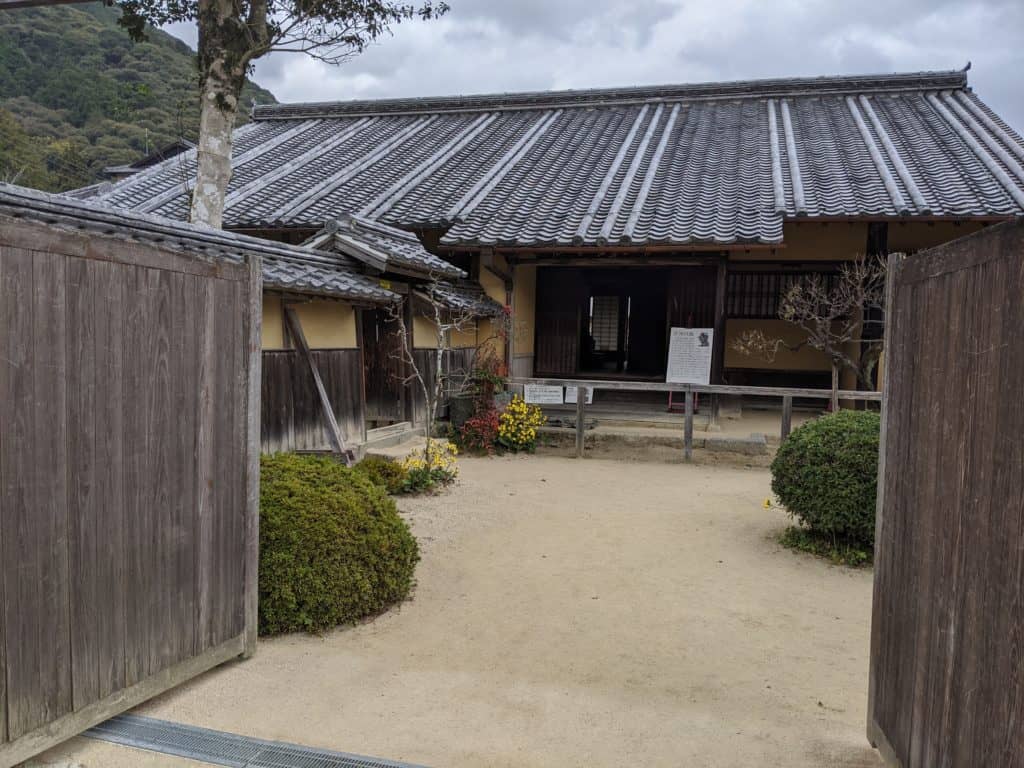
Kikko Shrine (吉根神社)
Kikko Shrine was built to enshrine the 吉川氏 (Kikkawa) family spirits. Originally built in 1728, it was moved to its current position in 1885. It was the Kikkawa family residence until the clans were abolished, after that it became government offices which is pretty common, most castle grounds have government offices on them now! Those offices were moved shortly thereafter and that’s when the shrine was moved. Oh, and when I say residence, think a palace like Kawagoe’s.
The Kinunkaku 錦雲閣 building which is a 絵馬堂 (emadou), or a place where votive picture tablets are hung, sits on the corner of the shrine and is picture-perfect with the surrounding moat waters. It was built in 1885 and is one of the Important Cultural Properties (重要文化財) at the shrine (several of the buildings have this designation).
If shrines are your thing, there are plenty of small ones in the area as well.
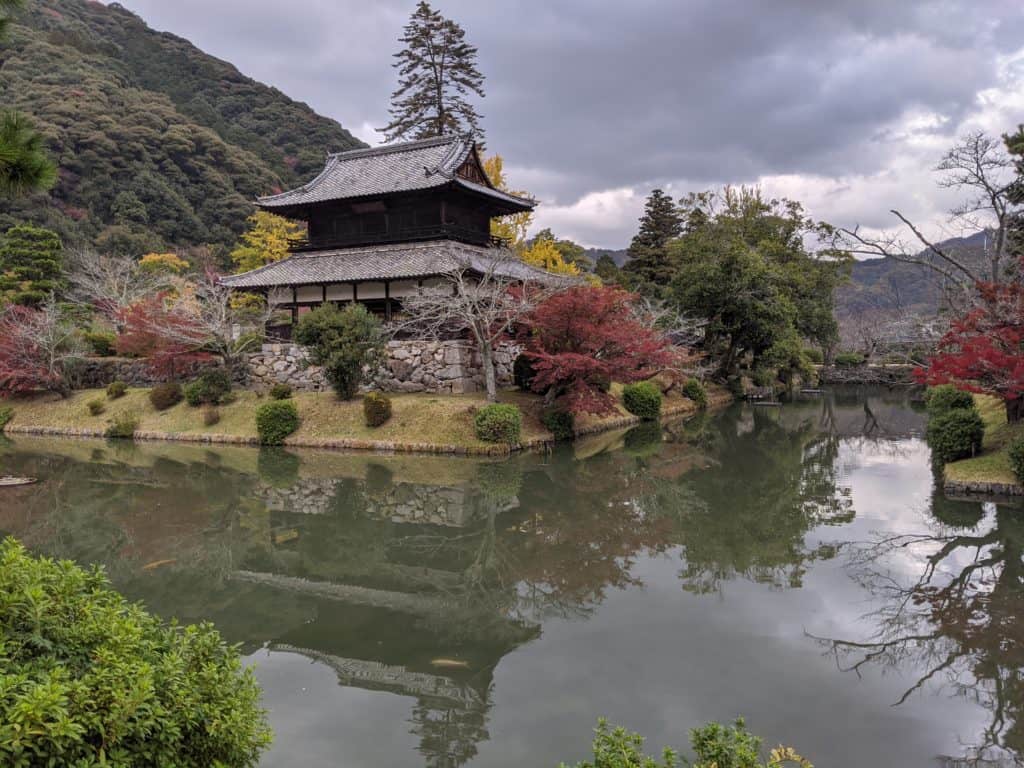
Local foods of Iwakuni Japan
There are tons of local ice cream shops, some with 100 different flavor choices but if you want a real taste of Iwakuni, you should try their own traditional sushi which is layers of rice and locally sourced lotus root and fish, very similar to Okayama’s local sushi delicacy. The town tourism board has this convenient walking map of all the sushi restaurants. A few are on the second floor overlooking Kintaikyo! The area is also famous for lotus root.
Looking for a street food option? Get a lotus croquettes – which if you haven’t discovered Japanese croquettes yet, they are so delicious! While the croquettes are “street food”, general etiquette in Japan has you stand and eat near where you purchased it, vice walking around and eating.
Personally, I ended up going for Japanese curry near the station at a cafe called “Cafe and Curry Alice”. They cook their blend of 30 spices for three days before serving it up. And you probably have figured by now that I love Japanese curry, whether it’s a chain like Cocoichiban or a mom-and-pop establishment.
This one was delicious, I had the 石焼き (ishiyaki) or baking that’s done with hot stones. It’s similar to the hot lava bowl usually used for bibimbap, Korea’s mixed rice with meat and veg. So I normally call it Japan’s bibimbap when I see it. Completely different than you normally see Japanese curry presented. Served in a blazing hot stone bowl, the rice on the edges gets nice and crispy. Just make sure not to burn your mouth!
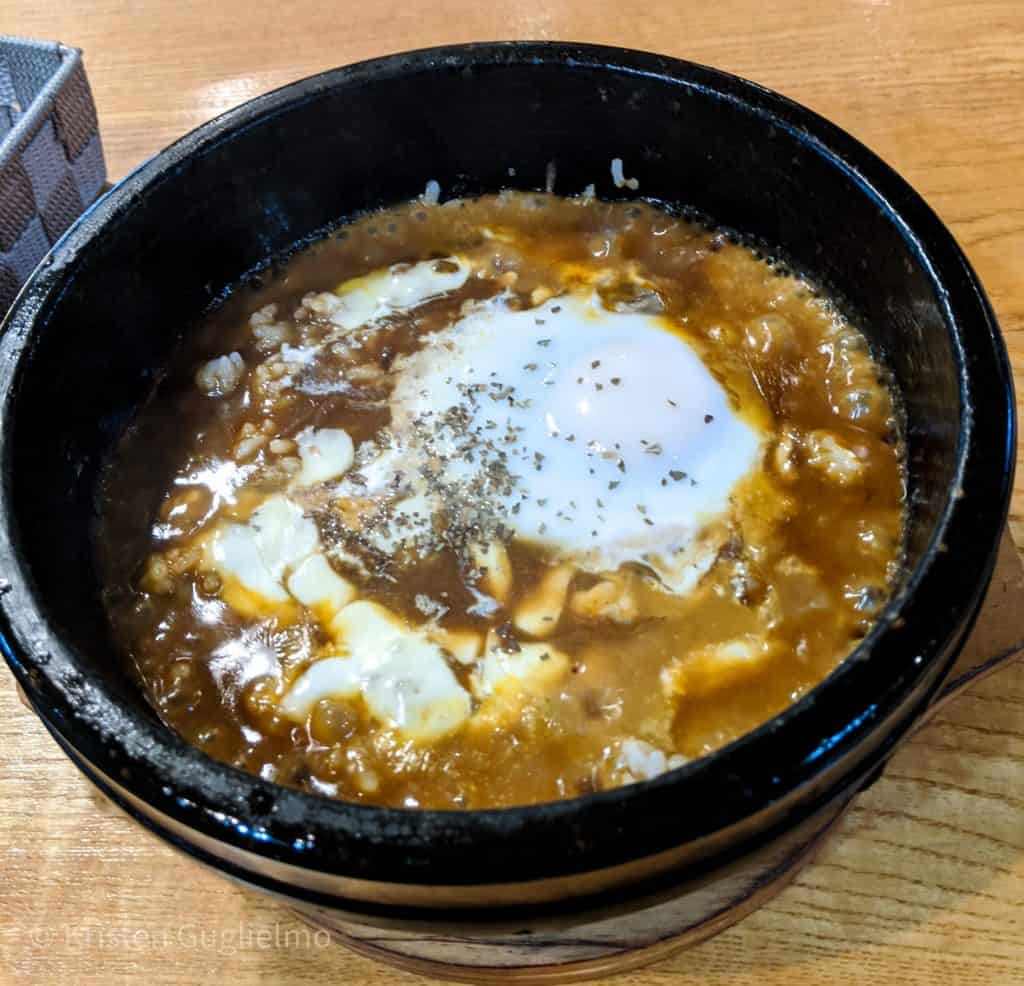
Where to find Iwakuni Souvenirs or Omiyage
In Japanese culture, you purchase omiyage (お土産) as a gift or souvenir when you travel somewhere for your family and even your co-workers. They are normally local specialty products and you will see omiyage stores all over the place when you are traveling in Japan.
If you are looking for some in Iwakuni, I found the shop at the bus stop had a good selection. There is also a small restaurant there to try out some of the local foods if you didn’t already decide on somewhere else.
Heading on? See JR Nishi-Iwakuni Station
If you took the shinkansen into Iwakuni and have the time to take the slow train to your next destination, instead of riding the bus back to JR Shin-Iwakuni station, take it the other direction to JR Nishi-Iwakuni Station. Or as I mentioned in the section on how to get there, it’s an easy walk! Why? Because JR Nishi-Iwakuni is a 登録有形文化財 or Registered Tangible Cultural Property of Japan.
If you want a big “bucket list”, go with these, there are a few thousand ;).
It reached such designation because it helps contribute to Japan’s historical esthetic. If architecture is your thing, check it out.
Other things in Iwakuni to extend your trip
Technically everything above already is a jam packed day and if you don’t get an early start, you might need more than a day anyway! However, they aren’t the only things in the area. I am always one for “leaving something for next time”, so here are a few things that are on my bucket list for Iwakuni.
And of course, if one of these fits your mood better, pick and choose what works best for you!
- Take a sake brewery tour. Murashige Sake Brewery is located close to the shinkansen station. They have Japan’s largest 杉玉 or sugidama which is the cedar balls you see outside of sake breweries. As best I can tell, it’s their goal to keep that so I’d go just for that even. There is also Sakai Sake Brewing 酒井酒造 and Asahi Shuzo 旭酒造 which makes Dassai sake, one of the leading in the world.
- Visit Iwakuni Art Museum (now called Kashiwahara Museum) located immediately next to the ropeway. I had originally planned on going but then had lofty goals of hitting Kokura Castle at the north end of Kyushu (not in the original plan but I free flow most of the time anyway) and so it didn’t actually fit into my trip. Its collection of thousands of artifacts and art contains a National Treasure Katana and tons of samurai weapons and armor to keep you busy.
- Enjoy the views of Iwakuni while relaxing in an onsen. While hot spring baths are amazing in general, it is such a treat when there is also a view!
- Try 高森和牛 (Takamori Wagyu). There are three top kinds of beef (三大和牛, yes, that three-thing again): most American’s know of Kobe, but there are “named” beef’s all around the country. Takamori has won many awards over the years and is famous for being rare. Only a few hundred cattle a year are produced to very stringent standards.
- Hike Jakuchikyo for one of the 100 best waters (名水百選) and 100 best waterfalls of Japan (日本の滝百選)… if you haven’t figured out Japan loves numbered things yet! But it does make for good lists of things to do already curated for you based on your interests. Now that I’ve hit my goal of visiting every prefecture, I’m working towards hitting every one of the 200 top castles in Japan. If castles are your thing, I suggest starting with the remaining original 12 castles of Japan.
Things to do in Yamaguchi Prefecture
I don’t think Yamaguchi gets enough love, there is pleny on my list to see here. So for some ideas for you, it’s not close to Iwakuni but is in Yamaguchi Prefecture, Akiyoshido Cave is way up on my list after loving Ryusendo Cave so much. Akiyoshido is the largest limestone cave in Japan.
Like I said with Takayama Inari Shrine, Fushimi Inari-taisha (伏見稲荷大社) isn’t the only shrine with “1000 torii” experiences. Motonosumi Inari Shrine leads down to the sea and just looks absolutely amazing.
And with that, I hope this post gives you the information you need to have the utmost best day trip to Iwakuni or gives you some ideas for a longer adventure. Heck, even if you are just here for the wanderlust, I hope you enjoyed it!
I can’t wait to hear about your experiences!
